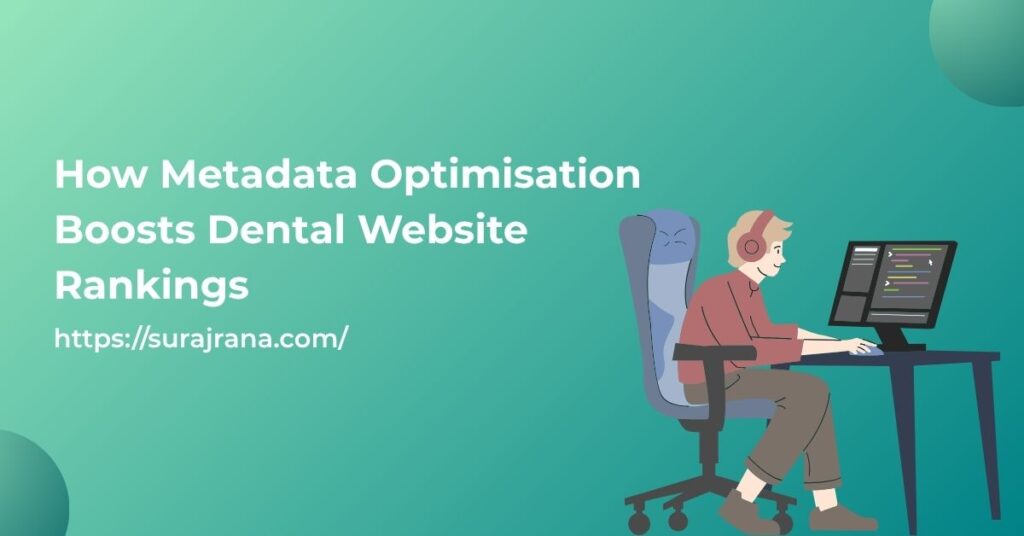Have you ever searched for a dentist online and noticed that certain clinics always appear at the top of the page? Meanwhile, others—maybe even better clinics—are nowhere to be found. So what makes one dental website show up on Google while another doesn’t?
One major reason is metadata. It might sound complicated, but it’s simply the information behind your website that helps Google understand what your site is about.
If your dental website has well-optimised metadata, it’s much more likely to show up higher in search results. That means more people will see it, click on it, and potentially become your patients.
Let’s break down what metadata is, how it affects your rankings, and how dentists can use it to bring more people to their website.
What Is Metadata and Why Does It Matter?
Simple Definition of Metadata
Metadata is like a label on a jar. The jar holds your actual content—like your services, blog posts, and images—and the metadata tells search engines what’s inside.
It isn’t always visible to visitors, but it plays a huge part in how your site is found online.
Think of it like this: If your website is a book in a library, metadata is the title and description on the back cover.
Without it, it’s harder for someone—or in this case, a search engine—to know what’s inside and who it’s for.
That’s why working with the Best Dental SEO Agency can help ensure your metadata is clear, optimised, and targeted to the right audience—so your site gets found by the patients who need you most.
The Role of Metadata in SEO
Search engines like Google scan millions of websites to decide which ones should appear first when someone types in a search.
Metadata helps them figure this out. It gives Google clues about your page’s content, what services you offer, and where you’re located.
When your metadata is clear and uses relevant keywords—like “dentist in West Ryde”—Google is more likely to show your site to people nearby who are searching for dental care.
Key Metadata Elements That Impact Dental Website Rankings
Title Tags
Your title tag is the clickable headline that appears on Google when someone searches for a dental service.
It’s also what shows up in the browser tab. A well-written title tag should clearly explain what the page is about and include keywords that your patients might type into Google.
For example, instead of a vague title like “Home,” your homepage title could be “Trusted Family Dentist in Liverpool | Smile Dental Clinic.” This tells both search engines and people exactly what you offer and where you’re located.
When done right, title tags become a powerful part of dental SEO, helping your clinic rank higher and attract more local patients.
Meta Descriptions
The meta description is the short paragraph under the title in search results. It doesn’t directly improve rankings, but it plays a big role in getting people to click your link.
A strong meta description might say something like, “Looking for a gentle and affordable dentist in Liverpool? Our friendly team offers expert care for all ages.” This gives searchers a reason to choose your clinic over others.

Header Tags (H1, H2, H3)
Header tags are the headings you see on a webpage. These help break up your content into easy-to-read sections. They also help Google understand the structure of your content.
For example, your main page title should be in an H1 tag, subtopics in H2s, and smaller points in H3s. When used properly, these tags make your page clearer for both search engines and human readers.
Image Alt Text
Alt text is the description added to your website’s images. If a photo doesn’t load, this text appears instead. It’s also read by screen readers for people with vision issues, making your site more accessible.
From an SEO point of view, alt text helps your images appear in Google Images and supports your site’s overall relevance. For example, using alt text like “dentist showing child how to brush teeth” is helpful for both users and search engines.
How Metadata Helps Dental Websites Rank Higher
Google Uses Metadata to Understand Your Site
Google needs to know what your website is about before it can show it in search results. Metadata gives it that information.
If your title tag says “Emergency Dentist in Penrith,” and your content matches, Google knows your site is a good fit for people searching for urgent dental care in that area.
When your metadata lines up with what people are looking for, your chances of ranking higher go up.
Improves Click-Through Rate (CTR)
Click-through rate, or CTR, is how often people click your link after seeing it in search results. If your title and description are boring or unclear, people might scroll past—even if you’re on page one.
On the other hand, clear and appealing metadata makes your link more attractive. A title like “Fast Tooth Pain Relief in Parramatta – Book Today” is more likely to grab attention than something generic.
More clicks tell Google that your page is helpful, which can boost your ranking even more.
Helps With Local SEO
Most people searching for a dentist want someone nearby. That’s where local SEO comes in. By including your suburb or city in your metadata, you tell search engines exactly where you are.
This is especially helpful for clinics with multiple locations or those trying to stand out in a crowded area.
For example, using “Cosmetic Dentist in Ashfield” in your title tag helps connect you with patients looking for that specific service in that area.
Best Practices for Metadata Optimisation
Use Relevant Keywords Naturally
One of the most important steps is using keywords that real people are typing into Google. These might include phrases like “children’s dentist in Blacktown” or “tooth implants in West Ryde.” But it’s important to use them naturally, not just stuff them in.
A great example is using SEO for dentist websites to identify what people are searching for and where to add those words effectively.
Keep Title Tags and Descriptions Within Length Limits
If your title tag is too long (over 60 characters) or your meta description is too long (over 160 characters), Google might cut them off. This could make your message incomplete or confusing.
Keeping your metadata within these limits helps people see your full message in search results, increasing the chance they’ll click.
Write for Humans First, Google Second
It’s easy to focus too much on keywords and forget the person reading your content. But search engines reward websites that are useful and easy to understand.
Avoid titles like “Dental teeth services dentist in Ryde clean dentist.” They might have lots of keywords, but they don’t make sense. A better title would be “Experienced Dentist in Ryde Offering Cleanings, Fillings, and More.”
Writing naturally helps both people and search engines.
Real-Life Example: How Metadata Changed One Clinic’s Traffic
Let’s look at a real-world example. A dental clinic in a busy Sydney suburb had a professional-looking website, but it wasn’t getting much traffic or phone calls.
They hadn’t updated their metadata since the site was built. After working with an SEO for dentist specialist to improve their title tags, meta descriptions, and image alt text, the clinic saw a noticeable increase in online visibility.
Within weeks, more patients were finding them through search engines, and their appointment bookings started to rise.
Let me know if you want this shortened, expanded, or tailored to a specific location.
After reviewing their site, they made the following changes:
- Updated title tags to include local keywords like “Emergency Dentist in Sydney CBD”
- Rewrote meta descriptions to clearly explain their services and invite users to book
- Added alt text to all images, describing what each photo showed
- Fixed heading tags so the content was easier to read and better structured
Within two months, their site moved from page 3 to page 1 on Google for several keywords. Website visits nearly doubled, and the number of patient calls increased by 40%.
This simple update made a big difference—without needing a full website redesign.
Conclusion
Metadata might not be visible on your website’s surface, but it plays a huge role in how well your dental clinic ranks on Google.
Elements like title tags, meta descriptions, and image alt text help search engines understand what your site offers and who it’s for.
Even small improvements to your metadata can make your website easier to find, bring in more clicks, and attract more local patients.
It’s a simple step that can lead to real growth—especially if your site hasn’t been updated in a while.
If you’re unsure where to begin, Suraj Rana can help. With experience in improving dental website performance, he focuses on clear, proven strategies that deliver results.
Now is a great time to take a quick look at your site’s metadata. You don’t need a full redesign—just a few small changes could lead to more traffic and more bookings at your practice.

My name is Suraj Rana, and I am a seasoned Dental SEO Specialist with extensive experience in the Dental SEO industry. Leveraging my deep knowledge and expertise, I help dental practices enhance their online visibility and attract more patients.


